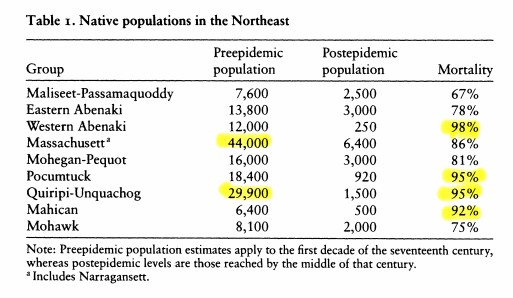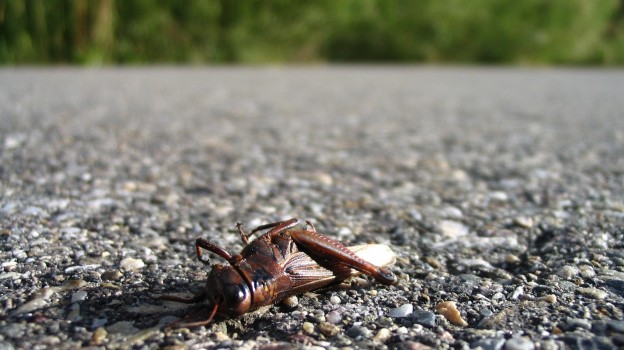In Eurasia, smallpox was undoubtedly a killer. It came and went in waves for ages, changing the course of empires and countries. 30% of those infected with the disease died from it. This is astonishingly high mortality from a disease – worse than botulism, Lassa Fever, tularemia, the Spanish flu, Legionnaire’s disease, and SARS.
In the Americas, smallpox was a rampaging monster.
When it first appeared Hispaniola in 1518, it spread 150 miles in four months and killed 30-50% of people. Not just of those infected, of the entire population1. It’s said to have infected a quarter of the population of the Aztec Empire within two weeks, killing half of those2, and laying the stage for another disease to kill many more3.
Then, alongside other diseases and warfare, it contributed to 84% of the Incan Empire dying4.
Among the people who sometimes traded at the Hudson Bay Company’s Cumberland House on the Seskatchewan River in 1781 and 1782, 95% seemed to have died. Of them, the U’Basquiau (also called, I believe, the Basquia Cree people) were entirely killed5.
Over time, smallpox killed 90% of the Mandan tribe, along with 80% of people in the Columbia River region, 67% of the Omahas, and half of the Piegan tribe and of the Huron and Iroquois Confederations6.
Here are some estimates of the death rates between ~1605 and 1650 in various Northeastern American groups. This was during a time of severe smallpox epidemics. Particularly astonishing figures are highlighted (mine).

Figure adapted from European contact and Indian depopulation in the Northeast: The timing of the first epidemics[^7]
When we look at the impact of smallpox in the Americas, we see extremely fast death rates that are worse than the worst forms of Ebola.
What happened?
In short, probably a total lack of previous exposure to smallpox and the other pathogenic European diseases, combined with cultural responses that helped the pathogen spread. The fact that smallpox was intentionally spread by Europeans in some cases probably contributed, but I’m not sure how much.
Virgin soil
Smallpox and its relatives in the orthopox family – monkeypox, cowpox, horsepox, and alastrim (smallpox’s milder variant) – had been established in Eurasia and Africa for centuries. Exposure to one would give some immune protection to the others. Variolation, a cruder version of vaccination, was also sometimes practiced.
Between these, and the frequent waves of outbreaks, a European adult would have survived some kind of direct exposure to smallpox-like antigens in the past, and would have the protection of antibodies to it, preventing future sickness. They would also have had, as children, the indirect protection of maternal antibodies, protecting them as children1.
In the Americas, everyone was exposed to the most virulent form of the disease with no defenses. This is called a “virgin soil epidemic”.
In this case, epidemics would stampede through occasionally, ferociously but infrequently enough for any given tribe that antibodies wouldn’t successfully form, and maternal protection didn’t develop. Many groups were devastated repeatedly by smallpox outbreaks over decades, as well as other European diseases: the Cocolizti epidemics3, measles, influenza, typhoid fever, and others7.
In virgin soil epidemics, including these ones, disease strikes all ages: children and babies, the elderly and strong young adults6. This sort of indiscriminate attack on all age groups is a known sign in animal populations that a disease is extremely lethal8. In humans, it also slows the gears of society to a halt.
When so much of the population of a village was too sick to move, not only was there nobody to tend crops or hunt – setting the stage for scarcity and starvation – but there was nobody to fetch water. Dehydration is suspected as a major cause of death, especially in children16. Very sick mothers would also be unable to nurse infants6.
Other factors that probably contributed:
Cultural factors
Native Americans had some concept of disease transmission – some people would run away when smallpox arrived in their village, possibly carrying and spreading the germ7. They also would steer clear of other tribes that had it. That said, many people lived in communal or large family dwellings, and didn’t quarantine the sick to private areas. They continued to sleep alongside and spend time with contagious people6.
In addition, pre-colonization Native American measures against diseases were probably somewhat effective to pre-colonization diseases, but tended to be ineffective or harmful for European diseases. Sweat baths, for instance, could have spread the disease and wouldn’t have helped9. Transmission could also have occurred during funerals10.
Looking at combinations of the above factors, death rates of 70% and up are not entirely unsurprising.
Use as a bioweapon
Colonizers repeatedly used smallpox as an early form of biowarfare against Native Americans, knowing that they were more susceptible. This included, at times, intentionally withholding vaccines from them. Smallpox also spreads rapidly naturally, so I’m not sure how much contributed to the overall extreme death toll, although it certainly resulted in tremendous loss of life.
Probably not responsible:
Genetics. A lack of immunological diversity, or some other genetic susceptibility, has been cited as a possible reason for the extreme mortality rate. This might be particularly expected in South America, because of the serial founder effect – in which a small number of people move away from their home community and start their own, repeated over and over again, all the way across Beringia and down North America, into South America9.
That said, this theory is considered unlikely today1. For one, the immune systems of native peoples of the Americas react similarly to vaccines as the immune systems of Europeans10. For another, groups in the Americas also had unusually high mortality from other European diseases (influenza, measles, etc), but this mortality decreased relatively quickly after first exposure – quickly enough that genetic attributes couldn’t change quickly enough to explain the response10.
Some have also proposed general malnutrition, which would weaken the immune system and make it harder to fight off smallpox. This doesn’t seem to have been a factor1. Scarce food was a fact of life in many Native American groups, but then again, the same was true for European peasants, who still didn’t suffer as much from smallpox.
Africa
Smallpox has had a long history in parts of Africa – the earliest known instance of smallpox infection comes from Egyptian mummies2, and frequent European contact throughout the centuries spread the disease to the parts they interacted with. Various groups in North, East, and West Africa developed their own variolation techniques11.
However, when the disease was introduced to areas it hadn’t existed before, we saw similarly astounding death rates as in the Americas: one source describes mortality rates of 80% among the Griqua people of South Africa. Less quantitatively, it describes how several Hottentot tribes were “wiped out” by the disease, that some tribes in northern Kenya were “almost exterminated”, and that parts of the eastern Congo River basin became “completely depopulated”2.
This makes it sound like smallpox acted similarly in unexposed people in Africa. It also lends another piece of evidence against the genetic predisposition hypothesis – that the disease would act similarly on groups so geographically removed.
Wikipedia also tells me that smallpox was comparably deadly when it was first introduced to various Australasian islands, but I haven’t looked into this further.
Extra
Required reading on humanism, smallpox, and smallpox eradication.
When smallpox arrived in India around 400 AD, it spurred the creation of Shitala, the Hindu goddess of (both causing and curing) smallpox. She is normally depicted on a donkey, carrying a broom for either spreading germs or sweeping out a house, and a bowl of either smallpox germs or of cool water.
The last set of images on this page also seems to be a depiction of the goddess, and captures something altogether different, something more dark and visceral.
Finally, this blog has a Patreon. If you like what you’ve read, consider giving it your support so I can make more of it.
References
- Riley, J. C. (2010). Smallpox and American Indians revisited. Journal of the history of medicine and allied sciences, 65(4), 445-477. ↩ ↩ ↩ ↩ ↩
- Fenner, F., Henderson, D. A., Arita, I., Jezek, Z., Ladnyi, I. D., & World Health Organization. (1988). Smallpox and its eradication. ↩ ↩ ↩
- Acuna-Soto, R., Sthale, D. W., Cleaveland, M. K., & Therrell, M. D. (2002). Megadrought and megadeath in 16th century Mexico. Revista Biomédica, 13, 289-292. ↩ ↩
- Beer, M., & Eisenstat, R. A. (2000). The silent killers of strategy implementation and learning. Sloan management review, 41(4), 29. ↩
- Houston, C. S., & Houston, S. (2000). The first smallpox epidemic on the Canadian Plains: in the fur-traders’ words. Canadian Journal of Infectious Diseases and Medical Microbiology, 11(2), 112-115. ↩
- Crosby, A. W. (1976). Virgin soil epidemics as a factor in the aboriginal depopulation in America. The William and Mary Quarterly: A Magazine of Early American History, 289-299. ↩ ↩ ↩ ↩ ↩
- Sundstrom, L. (1997). Smallpox Used Them Up: References to Epidemic Disease in Northern Plains Winter Counts, 1714-1920. Ethnohistory, 305-343. ↩ ↩
- MacPhee, R. D., & Greenwood, A. D. (2013). Infectious disease, endangerment, and extinction. International journal of evolutionary biology, 2013. ↩
- Snow, D. R., & Lanphear, K. M. (1988). European contact and Indian depopulation in the Northeast: the timing of the first epidemics. Ethnohistory, 15-33. ↩ ↩
- Walker, R. S., Sattenspiel, L., & Hill, K. R. (2015). Mortality from contact-related epidemics among indigenous populations in Greater Amazonia. Scientific reports, 5, 14032. ↩ ↩ ↩
- Herbert, E. W. (1975). Smallpox inoculation in Africa. The Journal of African History, 16(4), 539-559. ↩

